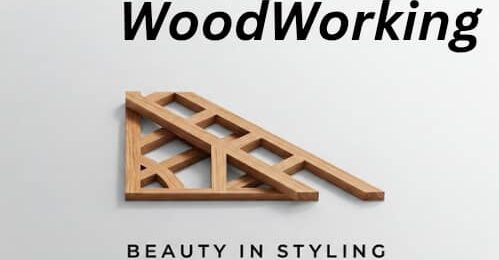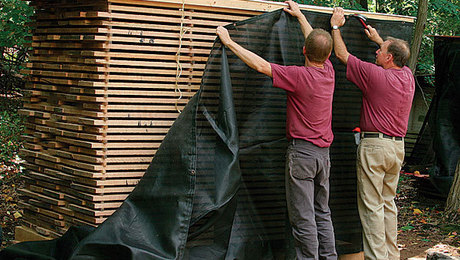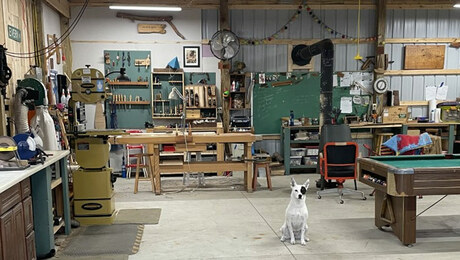STL353: A Big Bit of Community
In episode 353 of Shop Talk Live, host Ben Strano and cohost Mike Pekovich cover new happenings at Fine Woodworking before sitting down with Michigan woodworker Megan Shannon, founder of Tiny Bit of Wood, a community-based woodworking school in downtown Lansing. The episode opens with lighthearted shop talk about the latest Tools & Shops issue—celebrating the return of peel-off mailing labels—and Mike’s retrofit of his fluorescent shop lights with LED strips. They also preview new content, including Vic Tesolin’s “No Table Saw, No Problem” feature on alternative shop workflows, Andrew Finnegan’s lathe upgrades, and Adam Govier’s deep dive into sandpaper and finishing. Ben teases his upcoming 3D Printing for Woodworkers course, showing how digital fabrication tools like Fusion 360 and 3D-printed templates can streamline jig and hardware work in traditional shops.
Sign up for Ben’s 3D Printing for Woodworkers class now!
The second half features an inspiring interview with Megan Shannon, who left a 15-year teaching career to create Tiny Bit of Wood, a welcoming, hand-tool-focused school emphasizing accessibility, inclusion, and community. She discusses sourcing local urban lumber, building her space downtown, and developing affordable classes for adults and kids alike—including woodworking summer camps, free-build projects, and community efforts like a “Little Free Pantry.” Megan shares the challenges of balancing finances, insurance, and licensing with her mission to keep classes affordable and open to all, as well as her plans to transition the school into a nonprofit to expand scholarships and outreach. The conversation captures the heart of community-driven woodworking and the ways small shops can grow into hubs for creativity and connection.
Check out Tiny Bit Of Wood and take a class!
Every two weeks, a team of Fine Woodworking staffers answers questions from readers on Shop Talk Live, Fine Woodworking‘s biweekly podcast. Send your woodworking questions to [email protected] for consideration in the regular broadcast! Our continued existence relies upon listener support. So if you enjoy the show, be sure to leave us a five-star rating and maybe even a nice comment on our iTunes page. Join us on our Discord server here.
Show transcript:
Shop Talk Live — Episode 353
Participants: Ben Strano (Host), Mike Pekovich (Co‑host), Megan Shannon (Guest)
[Intro]
Ben: Welcome to Shop Talk Live, episode 353. We’ve got a fun show today. I’m joined by Mike Pekovich for some shop talk, and then an interview with Michigan woodworker and school owner Megan Shannon of Tiny Bit of Wood. I’ve followed her feed for a long time—she’s building a true community shop, with lots of kids’ classes and approachable instruction.
Mike: Sounds great. I’m not sure if I’ve seen her feed, but I’m in!
Ben: You’ll love it. She mills her own lumber, runs affordable classes, and really embodies the future of woodworking—community-centered, inclusive, and energetic.
[Tools & Shops Issue — Mailing Label Fix]
Ben: Tools & Shops just came out. It was a beast to produce, but it’s a good one. Best part? If you try to peel off the mailing label… it actually peels off!
Mike: That turned into a saga with our new printer. We had to explain why readers want labels that remove cleanly—collectors keep issues for decades. We finally solved it. I tested it at Florida School of Woodworking and waited for a second copy just to be sure before celebrating. Look for a “label that peels off” note in my Letter from the Editor around issue 321.
Ben: I didn’t realize how big a deal that was to folks. But judging by the emails—yup, it mattered. Glad it’s fixed.
[Shop Lighting Upgrade]
Ben: Shop lighting—update?
Mike: A friend helped retrofit my fluorescent fixtures with adhesive‑back LED strips. We yanked the ballasts, added drivers, and reused the old housings. It’s bright, simple, and I wish I’d done it sooner.
Ben: Can’t wait to see it.
[Lathe “Hot‑Rod” Follow‑Up]
Ben: Andrew Finnegan—pro turner who reviewed mid‑size lathes—is “hot‑rodding” a lathe for us. He’s demanding in the best way: great machine, then swap banjo, rests, centers—make it sing. We asked him to show exactly what he’d upgrade on a new lathe and what any of us might do to boost performance.
Mike: That article is going to be fantastic.
[“No Table Saw, No Problem”]
Ben: Our co‑host Vic has a feature: “No Table Saw, No Problem.” It’s not just “use a bandsaw for everything.” It’s a whole working system that doesn’t rely on a table saw.
Mike: In England we visited a school that used the table saw only for ripping. Everything else had another path. You can do real woodworking without a table saw as the center of the shop.
[Sandpaper Deep‑Dive; Hard‑Wax Oils]
Ben: Adam’s “All About Sandpaper” is huge—really a 101‑through‑301 treatment. He also covered sanding lights, tools, and materials. He’s an unsung hero—super thorough.
Mike: He also did that excellent hard‑wax oil finish review I’d wanted for years. Great work.
[Ben’s New Course: 3D Printing for Woodworkers (with Fusion 360)]
Ben: I’ve got a course coming out—“3D Printing for Woodworkers”—with a mini intro to Fusion 360. It started as a short class from Woodworking in America, then grew. We’ll release it before the next podcast—targeting November 11. It’s aimed at woodworkers who want to treat the printer as a shop tool, not a hobby in itself.
Mike: Perfect intersection. You’ve been using 3D printing in the shop for a long time.
Ben: Exactly. I show printable router templates for hinges—L‑shaped and offset knife hinges—with a 3/16 in. pattern bit from Amana that makes crisp mortises fast. I demonstrate bushing‑guided and flush‑trim approaches. Templates are cheap to print; I often toss them afterward and reprint when needed. For large jobs like Soss hinges, I’ll print multiples to work production‑style.
[Q&A: “Free” Walnut with Raccoon Urine & Concrete Storage]
Ben: Listener Michael writes: a friend offered free walnut boards stored in a barn for 40 years. Some were peed on by raccoons; the stack sat on a concrete floor. Worth a 300‑mile drive and a U‑Haul?
Mike: Absolutely yes. I recently re‑sawed an outdoor‑stored walnut beam—dirty outside, gorgeous inside. Air‑dried walnut is special: richer color than steamed, and essentially no internal stress, so it saws and stays flat. Any contamination likely affects only the outer fraction of an inch on the top boards—plane or saw it away. Wear gloves, maybe a mask, but go get it.
Ben: Worst case you see a friend and bring home half the stack. I’m convinced—go for it.
[Ad Break]
Ben (read): Keep Gorilla Wood Glue on the bench—water cleanup, natural color, bond stronger than the wood. Also check out Gorilla Wood Filler for durable repairs with stainability, paintability, and sandability.
— INTERVIEW —
Guest: Megan Shannon — Tiny Bit of Wood (Lansing, MI)
[Background & Origin]
Ben: First off, apologies—I once called you “Shannon” as a first name. Your last name is Shannon—Megan Shannon. You launched Tiny Bit of Wood in 2022. Where did the school idea come from?
Megan: My professional background is elementary education—15+ years. I was woodworking on the side, then left public schools to build furniture full‑time. Working alone was isolating, so I tried a couple classes in my home shop. Interest exploded, and I moved to a bigger space the next year.
[Local Lumber & Milling]
Ben: You’ve been milling your own wood for years—still locally harvesting?
Megan: Mostly, yes. I work with local arborists and community members. When a homeowner doesn’t want logs, I’ll take them. I’ve also started collaborating with the City of Lansing to mill storm‑felled and development‑removed trees for school use. I learned milling from an older sawyer and eventually upgraded to a Wood‑Mizer (about 22 in. capacity). No hydraulics—lots of pry bars and pipes—but it works.
[Downtown Location & Space]
Ben: Your space looks bright and welcoming online. Where are you located?
Megan: Right downtown Lansing—near the baseball stadium and the Capitol. The shop is about 3,500 sq. ft. with a wall of south‑facing windows. It used to be a bike shop. I kept the build‑out minimal—ADA restroom, drinking fountain, rubber flooring—so I didn’t have to pass big costs to students.
[Tools & Teaching Approach]
Ben: What machines are in the school?
Megan: Mostly hand‑tool focused to keep it approachable—plus bandsaws, a SawStop table saw, a miter saw, and a jointer. I mill and prep stock at home on larger machines, then bring it in so students can focus on layout and joinery safely.
[Classes, Schedule, and Growth]
Ben: How has your class lineup evolved?
Megan: I started with a handful of topics (frames, small boxes, cutting boards), and now rotate ~80 topics across spring/summer/fall/winter semesters—typically three class weekends per month (~12 sessions/month). Many students have progressed with me for years, so I’ve added more advanced classes gradually. I want it fun and attainable—not a $1,000 “perfect coffee table” on day one.
[Kids’ Programs, Camps, and Logistics]
Ben: You also teach a lot of kids—how did that come together?
Megan: That was the original goal, but the logistics (insurance, licensing) took time. I finally launched kids’ classes and camps. A typical Saturday session mixes ages 5–16 in project‑based classes (toolboxes, bird feeders, three‑leg stools with shavehorses), plus supervised bandsaw work. In summer and during school breaks, we run week‑long camps: learn a tool each morning, free‑build time, and a community build (like a Little Free Library/food pantry for outside the shop). We keep a 1:3 adult‑to‑child ratio (10 kids, 3 adults).
Ben: What about licensing and insurance?
Megan: It took calling many brokers to insure youth classes with real tools. Camps longer than a few hours/day require child‑care licensing; our first summer ran 10–2 to fit the rules, with plans to expand to full‑day once the license is in place.
[Affordability, Diversity, and Community]
Ben: You emphasize affordability and inclusivity.
Megan: Yes. The goal is accessible, welcoming classes at prices the community can reach. That means I teach a lot to cover rent and overhead, but it’s worth it. Our adult classes are diverse across age and background; plenty of first‑timers. Kids love rasps, files, spokeshaves—and they’re often more present and careful on machines than nervous adults.
[Other Arts & Visiting Instructors]
Ben: I’ve seen ceramics, drawing, and more on your site.
Megan: We host visiting instructors in adjacent crafts—hand‑built ceramics (fired off‑site), observational drawing, life drawing, papermaking, stamp carving, and screen printing. It keeps the space active and invites new folks into the shop. Next steps include hiring a woodworking instructor so I’m not teaching every weekend.
[Nonprofit Plans & Sponsorships]
Ben: What’s next?
Megan: We’re working to operate the school as a nonprofit. A local law firm is helping pro bono. It takes time—separating assets, school renting space from the business—but the goal is to unlock sponsorships and offer free or scholarship‑based kids’ programs for the community.
[Closing]
Ben: Megan, thanks for everything you’re building—it’s inspiring and vital for the craft.
Megan: Thank you! I’m having a blast.
Ben (closing): Follow Tiny Bit of Wood on Instagram, show Megan some love, and get inspired. If you’re on YouTube, hit thumbs‑up; if you’re on Discord, there’s a link in the description. And thanks to our Unlimited members and subscribers—your support keeps this podcast going. We’ll be back in two weeks.
Sign up for eletters today and get the latest techniques and how-to from Fine Woodworking, plus special offers.







